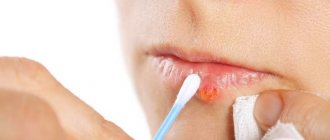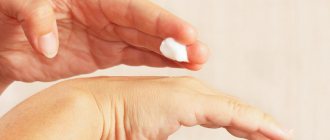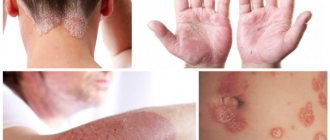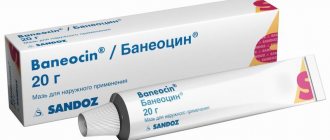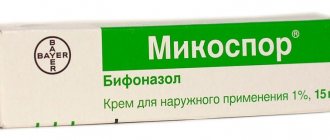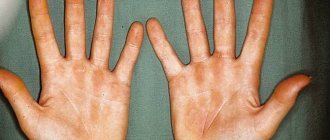Release form and composition
Dosage forms of Acyclovir-Akrikhina:
- tablets: flat-cylindrical in shape, with a chamfer and a dividing line, blue in color with light and dark blue inclusions, the presence of white spots is allowed (10 pieces in a strip pack, 2 packs in a cardboard box);
- ointment for external use 5%: a mass of almost white or white color, a characteristic odor may be present (2 g, 3 g or 5 g in an aluminum tube, 1 tube in a cardboard box).
1 tablet contains:
- active ingredient: acyclovir – 0.2 g or 0.4 g;
- auxiliary components: sodium carboxymethyl starch, povidone, microcrystalline cellulose, indigo carmine, magnesium stearate, purified water.
100 g of ointment contains:
- active ingredient: acyclovir – 5 g;
- auxiliary components: vaseline oil, petroleum jelly, propylene glycol, emulsion wax, polyethylene oxide 1500 (macrogol), purified water.
Pharmacological properties
Pharmacodynamics
Acyclovir, being a synthetic analogue of an acyclic purine nucleoside, has a highly selective effect on herpes viruses. The process of phosphorylation and conversion to acyclovir monophosphate occurs in cells containing viral thymidine kinase. Monophosphate is converted under the influence of guanylate cyclase into acyclovir diphosphate, then under the action of several cellular enzymes into triphosphate.
Acyclovir triphosphate blocks the synthesis of viral DNA (deoxyribonucleic acid) by being located in its chain and inhibiting the viral DNA polymerase. The rather high selectivity and specificity of the action is determined by its preferential accumulation in cells affected by the herpes virus.
Shows high activity against the Varicella zoster virus, which causes chickenpox and herpes zoster, the Herpes simplex virus (type 1 and 2), and the Epstein-Barr virus. Moderately active against cytomegaloviruses.
When treating herpes, it reduces the risk of skin dissemination and visceral complications, prevents the formation of new elements, accelerates the process of crust formation, and in the acute phase of herpes zoster, it reduces pain.
Pharmacokinetics
When taking tablets, the bioavailability of acyclovir can be 15–30%. The maximum concentration (Cmax) in blood plasma after taking the drug in a daily dose of 1 g reaches 0.7 mcg/ml after 1.5–2 hours.
Plasma protein binding ranges from 9 to 33%. Good ability to penetrate into all tissues and organs allows it to reach a concentration in the cerebrospinal fluid corresponding to 50% of the level in the blood plasma. Penetrates through the blood-brain and placental barriers and is excreted in breast milk.
Metabolized in the liver, forming 9-carboxymethoxymethylguanine, a pharmacologically inactive metabolite.
T1/2 (half-life) when taken orally – 2–3 hours. About 84% of the drug is excreted unchanged through the kidneys and about 14% in the form of a metabolite. Up to 2% is excreted through the gastrointestinal tract (GIT). Trace amounts of acyclovir are detected in the air exhaled by the patient.
In severe renal failure, T1/2 increases to 20 hours; with hemodialysis, the half-life is 5.7 hours. In this case, the concentration of acyclovir in the patient’s blood plasma decreases to 60% of the initial value.
When Acyclovir-Akrikhin ointment is applied externally, absorption in the affected area of the skin of the body is moderate, the concentration of acyclovir in the blood serum with normal renal function is up to 0.28 mcg/ml, with chronic renal failure - up to 0.78 mcg/ml.
Up to 9.4% of the daily dose of ointment is excreted by the kidneys.
Acyclovir-acriquine 5% 5g ointment for external use
pharmachologic effect
The antiviral drug is a synthetic analogue of thymidine nucleoside.
In infected cells containing viral thymidine kinase, phosphorylation occurs and is converted to acyclovir monophosphate. Under the influence of acyclovir guanylate cyclase, monophosphate is converted into diphosphate and, under the action of several cellular enzymes, into triphosphate. High selectivity of action and low toxicity to humans are due to the absence of the necessary enzyme for the formation of acyclovir triphosphate in intact cells of the macroorganism. Acyclovir triphosphate, being integrated into the DNA synthesized by the virus, blocks the reproduction of the virus. The specificity and very high selectivity of action are also due to its predominant accumulation in cells affected by the herpes virus. Highly active against Herpes simplex virus types 1 and 2. the virus that causes chickenpox and herpes zoster (Varicella zoster). Epstein-Barr virus. Moderately active against cytomegaloviruses.
Composition and release form Acyclovir-acriquine 5% 5g ointment for external use
Ointment for external use - 100 g:
- Active ingredient: acyclovir 5 g;
- Excipients: propylene glycol - 40 g, petroleum jelly - 12.5 g, vaseline oil - 7.5 g, emulsion wax - 5 g, macrogol (polyethylene oxide 1500) - 1 g, purified water - up to 100 g.
5 g in an aluminum tube.
Description of the dosage form
Ointment for external use 5% white or almost white; The presence of a characteristic odor is allowed.
Directions for use and doses
The drug is applied 5 times a day (every 4 hours).
Therapy should be continued until a crust forms on the blisters or until they are completely healed. The duration of therapy is on average 5 days, maximum 10 days.
If there is no effect, you should consult a doctor.
Pharmacodynamics
Prevents the formation of new rash elements, reduces the likelihood of skin dissemination and visceral complications, and accelerates the formation of crusts. Relieves pain in the acute phase of herpes zoster.
Pharmacokinetics
When used on intact skin, absorption is minimal. not detected in blood and urine. On affected skin, absorption is moderate. in patients with normal renal function, the serum concentration is up to 0.28 mcg/ml, in patients with chronic renal failure (CRF) - up to 0.78 mcg/ml. Excreted by the kidneys (up to 9.4% of the daily dose).
Indications for use Acyclovir-acriquine 5% 5g ointment for external use
Skin infections caused by Herpes simplex virus types 1 and 2, genital herpes, herpes zoster, chickenpox.
Contraindications
Hypersensitivity to acyclovir and other components of the drug.
The drug should be used with caution in case of dehydration and renal failure.
Application of Acyclovir-acriquine 5% 5g ointment for external use during pregnancy and breastfeeding
The use of the drug is indicated only in cases where the expected benefit to the mother outweighs the potential risk to the fetus.
During the treatment period, it is necessary to decide whether to stop breastfeeding.
special instructions
To achieve the maximum therapeutic effect, it is necessary to use the drug as early as possible (at the first signs of the disease: burning, itching, tingling, feeling of tension and redness).
The ointment is not recommended to be applied to the mucous membranes of the mouth and eyes, because the development of severe local inflammation is possible.
When treating genital herpes, you should avoid sexual intercourse or use condoms, because the use of acyclovir does not prevent transmission of the virus to partners.
Overdose
Data on drug overdose are not provided.
Side effects Acyclovir-acriquine 5% 5g ointment for external use
From the skin and subcutaneous tissues: hyperemia, dryness, peeling of the skin.
Other: burning, inflammation upon contact with mucous membranes. Allergic dermatitis may develop.
Drug interactions
When used externally, no interactions with other drugs were detected.
An enhanced effect is observed with the simultaneous administration of immunostimulants.
Indications for use
Pills
- genital herpes and other primary and secondary infections of the mucous membranes and skin caused by Herpes simplex viruses (type 1 and 2);
- primary and recurrent infections of the Varicella zoster virus (shingles, chickenpox);
- severe immunodeficiency (as part of complex therapy) after bone marrow transplantation and with HIV infection in the AIDS stage, early clinical manifestations and a detailed clinical picture;
- prevention of exacerbations of recurrent Herpes simplex virus infections (types 1 and 2) in patients with normal immune status;
- prevention of primary and recurrent Herpes simplex virus infections (types 1 and 2) in patients with immunodeficiency.
Ointment for external use 5%
- genital herpes;
- skin infections caused by Herpes simplex virus types 1 and 2;
- chicken pox;
- shingles.
Acyclovir-Akrikhin
The drug is taken orally, during or immediately after a meal, with a sufficient amount of water.
The dosage regimen is set individually depending on the severity of the disease.
When treating infections of the skin and mucous membranes caused by the Herpes simplex virus types 1 and 2, adults are prescribed 200 mg 5 times a day (every 4 hours while awake, excluding night sleep) for 5 days; when treating genital herpes - 10 days. If necessary, the duration of treatment can be increased.
As part of complex therapy for severe immunodeficiency, incl. with a developed clinical picture of HIV infection (including early clinical manifestations of HIV infection and the stage of AIDS), after bone marrow transplantation, 400 mg is prescribed 5 times a day.
To prevent relapses of infections caused by Herpes simplex viruses types 1 and 2, in patients with normal immune status, adults are prescribed 200 mg 4 times a day every 6 hours. The course duration is from 6 to 12 months.
To prevent infections caused by the Herpes simplex virus types 1 and 2, in patients with immunodeficiency, adults are prescribed 200 mg 4 times a day every 6 hours, the maximum dose is up to 400 mg of acyclovir 5 times a day, depending on the severity of the infection.
When treating herpes zoster - 800 mg 5 times a day (every 4 hours while awake, excluding night sleep) for 7-10 days.
For children over 3 years of age, the drug is prescribed in the same dose as for adults.
When treating chickenpox, adults and children over 6 years of age are prescribed 800 mg 4 times a day; children aged 3-6 years - 400 mg 4 times a day. More accurately, the dose can be determined at the rate of 20 mg/kg. The course of treatment is 5 days.
In patients with impaired renal function, dose adjustment and dosage regimen are necessary depending on the amount of CC and the type of infection. When treating an infection caused by Herpes simplex, with CC less than 10 ml/min, the daily dose of the drug should be reduced to 400 mg, divided into 2 doses (with intervals between them of at least 12 hours, i.e. 200 mg 2 times a day ). In the treatment of infections caused by Varicella zoster, and during maintenance therapy in patients with severe immunodeficiency - patients with CC 10-25 ml/min are prescribed the drug 800 mg 3 times a day with an interval of 8 hours, with CC less than 10 ml/min - according 800 mg 2 times a day with an interval of 12 hours.
Overdose
Symptoms: agitation, coma, convulsions, lethargy. Precipitation of acyclovir in the renal tubules is possible if its concentration exceeds the solubility in the renal tubules (2.5 mg/ml).
Treatment: symptomatic therapy.
Contraindications
- lactation period;
- breast-feeding;
- hypersensitivity to acyclovir, ganciclovir, valacyclovir and excipients of the drug.
Caution must be exercised when using Acyclovir-Akrikhin in patients with dehydration and renal failure.
In addition, the administration of the drug in tablet form to children under 3 years of age is contraindicated.
Caution should be used when taking Acyclovir-Akrikhin orally in case of neurological disorders or neurological reactions to taking cytotoxic drugs (including medical history), as well as in elderly patients.
Instructions for use of Acyclovir-Akrikhin: method and dosage
Pills
Acyclovir-Akrikhin tablets are taken orally, during or immediately after meals, with a sufficient amount of water.
The doctor prescribes the dosage regimen individually, taking into account clinical indications and the severity of the disease.
Recommended dosage:
- infections of the mucous membranes and skin caused by the Herpes simplex virus (types 1 and 2): adults – 0.2 g 5 times a day (every 4 hours). The duration of the course is 5 days, for the treatment of genital herpes – 10 days. If necessary, the treatment period can be extended;
- severe immunodeficiency in patients after bone marrow transplantation and with HIV infection: as part of complex therapy - 0.4 g 5 times a day;
- prevention of relapses of Herpes simplex virus infections (types 1 and 2) in patients with normal immunity: adults – 0.2 g 4 times a day every 6 hours. Treatment is long-term, from 6 to 12 months;
- prevention of Herpes simplex virus infection (types 1 and 2) in patients with immunodeficiency: adults – 0.2 g 4 times a day (with an interval of 6 hours). In case of a severe condition, the dose is increased to the maximum - 0.4 g 5 times a day;
- herpes zoster: adults and children - 0.8 g 5 times a day (during the day - every 4 hours, night interval - 8 hours) for 7-10 days;
- chicken pox: adults and children over 6 years old – 0.8 g 4 times a day; children aged 3–6 years – 0.4 g 4 times a day. To more accurately determine the individual dose, you can use the calculation - 0.02 g per 1 kg of patient weight. The course of treatment is 5 days.
If renal function is impaired, it is necessary to adjust the dose and dosage regimen, taking into account the value of creatinine clearance (CC) and the type of infection.
Ointment for external use 5%
Acyclovir-Akrikhin ointment is intended for external use. It should be applied with clean hands, or using a cotton swab, in a thin layer on the affected areas of the skin, covering the areas bordering them.
The procedures are carried out 5 times a day with an interval of 4 hours.
Treatment should be continued until a crust forms on the blisters or until they are completely healed. On average, the course of therapy can be 5 days.
If there is no effect after 10 days of using the ointment, you should consult a doctor.
Acyclovir-Akrikhin tablets 200 mg No. 20
A country
Russia
The country of production may vary depending on the batch of goods. Please check with the operator for detailed information when confirming your order.
Active substance
Acyclovir
Compound
Active substance: Acyclovir.
pharmachologic effect
Antiviral. It has a highly selective effect on herpes simplex viruses type 1 and 2, herpes zoster, Epstein-Barr and cytomegalovirus. Easily passes through the corneal epithelium (eye ointment) and creates a therapeutic concentration in the eye fluid. When used topically in the form of a cream, it is not absorbed into the systemic circulation. Penetrates through the BBB and the placental barrier, excreted in breast milk. In case of herpes, it prevents the formation of new rash elements, reduces the likelihood of skin dissemination and visceral complications, accelerates the formation of crusts, and reduces pain in the acute phase of herpes zoster. Has an immunostimulating effect.
Indications for use
Primary and recurrent herpetic lesions of the skin and mucous membranes (including genital herpes), herpetic lesions in patients with immunodeficiency (treatment and prevention), herpes zoster, chicken pox, simple herpetic keratitis.
Mode of application
Orally, adults and children over 2 years old - 0.2 g 5 times a day (except at night), for prevention - 0.2 g 4 times a day; for herpes zoster - 0.8 g 4 times a day; children under 2 years of age - half the dose for adults. The course of treatment is usually 5 days, for herpes zoster - another 3 days after the signs of the disease disappear. Preventive treatment for organ transplantation is carried out for 6 weeks.
Interaction
Probenecid slows down excretion (blocks tubular secretion).
Side effect
Headache, fatigue, neurological disorders, shortness of breath, nausea, vomiting, diarrhea, intestinal colic, fever, edema, lymphadenopathy, increased levels of bilirubin, urea, creatinine, transient increase in the activity of liver transaminases, allergic reactions in the form of skin rash, itching. With intravenous administration - agitation, impaired consciousness, lethargy, tremor, convulsions, hallucinations, psychosis, coma; reactions at the site of intravenous administration - local inflammation, phlebitis. For external use - erythema, peeling, burning sensation, burn.
Contraindications
Hypersensitivity, breastfeeding.
Overdose
Symptoms: headache, neurological disorders, shortness of breath, nausea, vomiting, diarrhea, renal failure, lethargy, convulsions, coma. Treatment: maintenance of vital functions, hemodialysis.
special instructions
Restrictions on use: Pregnancy. To prevent crystallization in the tubular apparatus, it is recommended to take large amounts of liquid. Caution should be exercised in patients with psychoneurotic disorders, impaired renal and liver function, electrolyte disturbances, severe hypoxia. It is recommended to apply the cream with rubber gloves to prevent infection of other areas of the skin. For more detailed information, see the instructions for use.
Dispensing conditions in pharmacies
On prescription
Side effects
Pills
- from the hematopoietic system: very rarely – leukopenia, thrombocytopenia, anemia;
- from the digestive system: diarrhea, abdominal pain, nausea, vomiting; rarely - a reversible increase in the activity of liver enzymes and bilirubin levels;
- from the central nervous system: weakness, drowsiness, dizziness, headache, increased fatigue, confusion, paresthesia, decreased concentration, agitation, convulsions, hallucinations;
- from the urinary system: rarely - increased concentrations of creatinine and urea in the blood plasma; very rarely - acute renal failure;
- allergic reactions: skin itching, rash, urticaria, Lyell's syndrome, erythema multiforme (including Stevens-Johnson syndrome), anaphylaxis, angioedema;
- other: fever, blurred vision, lymphadenopathy, myalgia, alopecia, peripheral edema.
Ointment for external use 5%
- dermatological reactions: hyperemia, dryness and flaking of the skin;
- other: possible – allergic dermatitis; upon contact with mucous membranes - burning sensation, inflammation.
special instructions
When taking tablets, it is recommended to monitor kidney function by examining the blood for urea and creatinine levels in the blood plasma.
During the treatment period, the patient should drink enough fluid.
It should be taken into account that in case of reduced immunity, prolonged treatment or repeated use of acyclovir may cause the appearance of strains of viruses in the patient that are insensitive to the action of the drug.
Since taking the drug does not prevent sexual transmission of herpes, it is recommended to avoid sexual intercourse or use barrier contraception during treatment, even if there are no clinical manifestations of the disease.
The maximum therapeutic effect is achieved if the use of the ointment is started from the moment the first signs of the disease appear, such as itching, tingling, burning, redness, and a feeling of tension.
Due to the possible development of severe local inflammation, Acyclovir-Akrikhin ointment should not be applied to the mucous membranes of the eyes and oral cavity.
Impact on the ability to drive vehicles and complex mechanisms
While taking the pills, you should be careful when performing potentially dangerous activities that require concentration and high speed of psychomotor reactions, including driving.
For impaired renal function
Both forms of Acyclovir-Akrikhin are used with caution in patients with renal failure.
When prescribing tablets to patients with impaired renal function, it is necessary to adjust the dose and dosage regimen, taking into account the value of creatinine clearance (CC) and the type of infection. For the treatment of Herpes simplex infection in patients with CC less than 10 ml/min, 0.2 g should be prescribed 2 times a day with an interval of 12 hours.
When treating Varicella zoster infection and prescribing the drug to patients with severe immunodeficiency, a dose of 0.8 g is used as maintenance therapy: for CC 10–25 ml/min - 3 times a day (every 8 hours), for CC less than 10 ml/min - 2 once a day (every 12 hours).
Acyclovir-Acri tablet 400 mg No. 20 45159
Description
Absorbed in the gastrointestinal tract by 20%. Relatively weakly binds to plasma proteins. The concentration in the cerebrospinal fluid is 50% of the plasma level. During biotransformation it forms 9-carboxymethoxymethylguanine. It is excreted in the urine unchanged and as a metabolite (10–15%). Average T1/2 - 3 hours. Prevents the formation of new rash elements, reduces the likelihood of skin dissemination and visceral complications, accelerates the formation of crusts. Relieves pain in the acute phase of herpes zoster.
Compound
Tablets 1 tablet. acyclovir 0.4 g in a blister pack of 10 pcs.; 2 packs in a cardboard box. Ointment 5% 1 g acyclovir 0.05 g in tubes of 5 g; in a cardboard pack 1 tube.
Application
Infections of the skin and mucous membranes caused by the herpes simplex virus (types 1, 2), including primary and recurrent genital herpes, and the herpes zoster virus; prevention of infections of the skin and mucous membranes in patients with reduced immunity. Contraindicated during pregnancy (passes the hematoplacental barrier). During treatment, you should stop breastfeeding (passes into breast milk). Tablets: rarely - nausea, vomiting, diarrhea, headache, increased fatigue, deterioration of hematological parameters, increased bilirubin content in plasma, increased activity of liver enzymes, allergic reactions. Ointment: rarely - peeling at the site of application, local irritation of the mucous membrane, burning, pain. Probenecid slows down excretion. Tablets: orally; adults and children over 2 years old for the treatment of herpetic diseases - 0.2 g 5 times a day for 5 days; for immunodeficiency - a single dose is increased to 0.4 g. For the prevention of herpetic infections in patients with immunodeficiency - 0.2 g 4 times a day. Infections caused by the herpes zoster virus: 0.8 g 5 times a day for 7 days. Patients with impaired renal function need to adjust the dosage regimen: if creatinine Cl is less than 10 ml/min, the daily dose is reduced to 0.4 g in 2 divided doses with an interval between doses of at least 12 hours. In the treatment of infections caused by Varicella zoster and maintenance therapy of patients with a pronounced decrease in immunity and creatinine Cl 10–25 ml/min - 2.4 g/day in 3 divided doses with an interval of 8 hours. In patients with creatinine Cl less than 10 ml/min, the daily dose is reduced to 1.6 g in 2 divided doses with at intervals of 12 hours. Children under 2 years old - half the adult dose. Ointment: apply a thin layer to the affected area immediately after the first signs of the disease appear 5 times a day (every 4 hours) for 5–10 days. Hypersensitivity.
